
The Emerald Buddha is an image of the meditating Gautama Buddha seated in a meditative posture, made of a semi-precious green stone, clothed in gold. and about 66 centimetres (26 in) tall. The image is considered the sacred palladium of Thailand. It is housed in the Temple of the Emerald Buddha on the grounds of the Grand Palace in Bangkok.
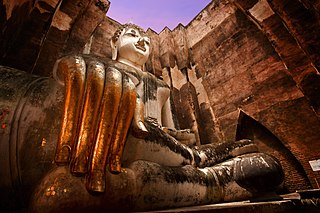
Sukhothai Historical Park covers the ruins of Sukhothai, literally 'dawn of happiness', capital of the Sukhothai Kingdom in the 13th and 14th centuries, in north central Thailand. It is near the city of Sukhothai, capital of Sukhothai Province.
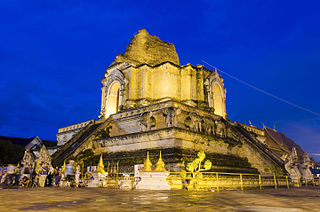
Wat Chedi Luang is a Buddhist temple in the historic centre of Chiang Mai, Thailand. The current temple grounds were originally made up of three temples — Wat Chedi Luang, Wat Ho Tham and Wat Sukmin.
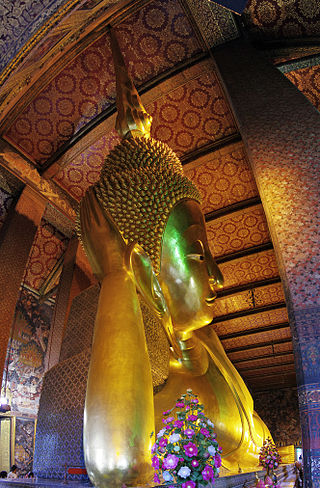
Wat Pho, also spelled Wat Po, is a Buddhist temple complex in the Phra Nakhon District, Bangkok, Thailand. It is on Rattanakosin Island, directly south of the Grand Palace. Known also as the Temple of the Reclining Buddha, its official name is Wat Phra Chetuphon Wimon Mangkhalaram Rajwaramahawihan. The more commonly known name, Wat Pho, is a contraction of its older name, Wat Photaram.

Phra Pathommachedi or Phra Pathom Chedi is a Buddhist stupa in Thailand. The stupa is located in the Wat Phra Pathommachedi Ratcha Wora Maha Wihan (Thai: วัดพระปฐมเจดีย์ราชวรมหาวิหาร), a temple in the town center of Nakhon Pathom, Nakhon Pathom Province, Thailand. Phra Pathommachedi is the tallest stupa in the world. The top of its spire reaches 120.45 meters, with the base circumference of 235.50 meters.

Wat Phra Kaew is a third-common-class royal temple situated in the area of 10,640 square metres on Trairat road, Wiang sub-district, Muang Chiang Rai in Chiang Rai City, Thailand. The King of Thailand upgraded the temple to the royal temple on May 31, 1978. The temple gains historical importance as the place where the Emerald Buddha was found. It is also one of the main centres of Buddhist education and the Sangha's administration in northern Thailand.

The Silver Pagoda is located on the south side of the Royal Palace in Chey Chumneas, Phnom Penh. The official name is Wat Ubaosoth Ratanaram, also known as Wat Preah Keo Morakot which is commonly shortened to Wat Preah Keo in Khmer.

Wat Pavaranivesh Vihara Ratchawarawihan is a major Buddhist temple (wat) in Phra Nakhon district, Bangkok, Thailand. Being the residence of Nyanasamvara Suvaddhana; the late Supreme Patriarch of Thailand, it is the final resting place of two former kings of Chakri Dynasty; King Vajiravudh and King Bhumibol Adulyadej. The temple was established in 1824 by Mahasakti Pol Sep, viceroy during the reign of King Rama III.

Thai temple art and architecture is the art and architecture of Buddhist temples in Thailand. Temples are known as wats, from the Pāḷi vāṭa, meaning "enclosure". A temple has an enclosing wall that divides it from the secular world. Temples served as a stabilizing center in these communities because their sacred teachings became a basis of authority and boundaries, their precincts became places of instruction, their regimes of common ownership of property formed them into economic centers, and their functions allowed them to serve at the heart of these communities in a variety of ways.

Chofa is a Lao and Thai architectural decorative ornament that adorns the top at the end of wat and palace roofs in most Southeast Asian countries, such as Thailand, Cambodia, Laos, and Myanmar. It resembles a tall thin bird and looks hornlike. The chofa is generally believed to represent the mythical creature Garuda, half bird and half man, who is the vehicle of the Hindu god Vishnu.
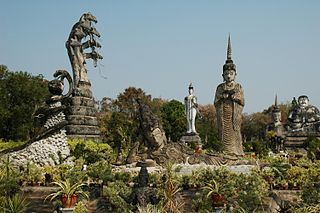
Sala Keoku is a park featuring giant fantastic concrete sculptures inspired by Buddhism and Hinduism. It is located near Nong Khai, Thailand in immediate proximity of the Thai-Lao border and the Mekong river. The park has been built by and reflects the vision of Luang Pu Bunleua Sulilat and his followers. The construction started in 1978. It shares the style of Sulilat's earlier creation, Buddha Park on the Lao side of Mekong, but is marked by even more extravagant fantasy and greater proportions.
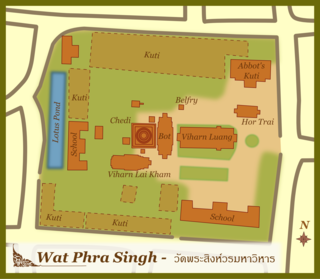
Wat Phra Singh is a Buddhist temple in Chiang Mai, northern Thailand. King Ananda Mahidol, bestowed upon it the status of Royal temple of the first grade in 1935.
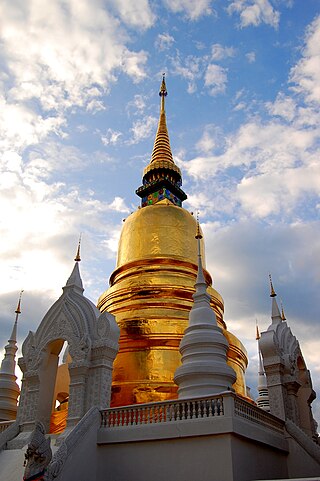
Wat Suan Dok, also known as Wat Buppharam is a Buddhist temple (Wat) in Chiang Mai, northern Thailand. It is a Royal Temple of the Third Class. The temple is on Suthep Road, approximately one kilometre west of Suan Dok gate at the west side of the moat.

Luang Prabang is a province in northern Laos. Its capital of the same name, Luang Prabang, was the capital of the Lan Xang Kingdom during the 13th to 16th centuries. It is listed since 1995 by UNESCO as a World Heritage Site for unique architectural, religious and cultural heritage, a blend of the rural and urban developments over several centuries, including the French colonial influences during the 19th and 20th centuries. The province has 12 districts. The Royal Palace, the national museum in the capital city, and the Phou Loei Protected Reserve are important sites. Notable temples in the province are the Wat Xieng Thong, Wat Wisunarat, Wat Sen, Wat Xieng Muan, and Wat Manorom. The Lao New Year is celebrated in April as The Bun Pi Mai.

Wat Phra Si Sanphet was the holiest temple on the site of the old Royal Palace in Thailand's ancient capital of Ayutthaya until the city was completely destroyed by the Burmese in 1767, during the Burmese–Siamese War. It was the grandest and most beautiful temple in the capital and it served as a model for Wat Phra Kaew in Bangkok.

Wat Ratchapradit Sathit Mahasimaram Ratcha Wora Maha Viharn is a Buddhist temple in the Phra Nakhon District of Bangkok. Wat Ratchaparadit was designated a first-class royal monastery in 1915, making it one of the most significant temples in Thailand.

Wat Vihear Suor is a Theravada Buddhist temple located in Kandal Province, Cambodia. It was built on an older pre-Buddhist cult site belonging to the Angkor era.
Stupas in Cambodia more often referred to as chedi are steeple-shaped mausoleums holding the bones and ashes of the deceased placed throughout the grounds of a pagoda, typically found in Cambodia, usually financed by wealthier believers for themselves and their relatives. While the prang derived from the Indian shikhara prototype, the chedi felt both the Indian influence, through the prototype of the stupa, especially that of Sanchi, as well as other influences, especially with the prototype stupa of Ruwanwelisaya in Ceylan, from where Theravada Buddhism also arrived.












































